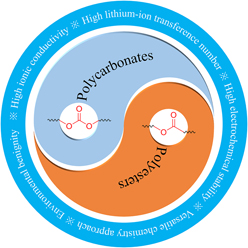Crossref Citations
This article has been cited by the following publications. This list is generated based on data provided by
Crossref.
Xu, Hongli
Xie, Jingbing
Liu, Zhongbo
Wang, Jun
and
Deng, Yonghong
2020.
Carbonyl-Coordinating Polymers for High-Voltage Solid-State Lithium Batteries: Solid Polymer Electrolytes - ERRATUM.
MRS Energy & Sustainability,
Vol. 7,
Issue. 1,
Meabe, Leire
Peña, Sergio Rodriguez
Martinez-Ibañez, Maria
Zhang, Yan
Lobato, Elias
Manzano, Hegoi
Armand, Michel
Carrasco, Javier
and
Zhang, Heng
2020.
Insight into the Ionic Transport of Solid Polymer Electrolytes in Polyether and Polyester Blends.
The Journal of Physical Chemistry C,
Vol. 124,
Issue. 33,
p.
17981.
Blancas Flores, José Miguel
Pérez García, María Guadalupe
González Contreras, Gabriel
Coronado Mendoza, Alberto
and
Romero Arellano, Victor Hugo
2021.
Polydimethylsiloxane nanocomposite macroporous films preparedviaPickering high internal phase emulsions as effective dielectrics for enhancing the performance of triboelectric nanogenerators.
RSC Advances,
Vol. 11,
Issue. 1,
p.
416.
Deacy, Arron C.
Gregory, Georgina L.
Sulley, Gregory S.
Chen, Thomas T. D.
and
Williams, Charlotte K.
2021.
Sequence Control from Mixtures: Switchable Polymerization Catalysis and Future Materials Applications.
Journal of the American Chemical Society,
Vol. 143,
Issue. 27,
p.
10021.
Boldrin, Maria Valnice
Irikura, Kallyni
Costa e Silva, Beatriz
Cardoso, Juliano Carvalho
Stulp, Simone
Moraes da Silva, Caroline
Frem, Regina Célia Galvão
Candia-Onfray, Christian
Rojas, Susana
and
Salazar, Ricardo
2021.
Metal−Organic Frameworks for Carbon Capture and Energy.
Vol. 1393,
Issue. ,
p.
395.
Olmedo-Martínez, Jorge L.
Pastorio, Michele
Gabirondo, Elena
Lorenzetti, Alessandra
Sardon, Haritz
Mecerreyes, David
and
Müller, Alejandro J.
2021.
Polyether Single and Double Crystalline Blends and the Effect of Lithium Salt on Their Crystallinity and Ionic Conductivity.
Polymers,
Vol. 13,
Issue. 13,
p.
2097.
Wei, Zhenyao
Zhang, Tian
Wang, Man
Wu, Wei
Wang, Jun
Li, Shuai
Zhao, Yusheng
Wang, Chaoyang
Yao, Xiayin
Xu, Xiaoxiong
and
Deng, Yonghong
2021.
Formation of Excellent Cathode/Electrolyte Interface with UV-Cured Polymer Electrolyte through In Situ Strategy.
Journal of The Electrochemical Society,
Vol. 168,
Issue. 2,
p.
020511.
Shen, Zhichuan
Zhong, Jiawei
Jiang, Shiyong
Xie, Wenhao
Zhan, Shiying
Lin, Kaiji
Zeng, Linyong
Hu, Hailing
Lin, Guide
Lin, Yuhan
Sun, Shuhui
and
Shi, Zhicong
2022.
Polyacrylonitrile Porous Membrane-Based Gel Polymer Electrolyte by In Situ Free-Radical Polymerization for Stable Li Metal Batteries.
ACS Applied Materials & Interfaces,
Vol. 14,
Issue. 36,
p.
41022.
Chen, Yuncai
Woo, Haw Jiunn
Syed Mohd Fadzil, Sharifah Athira Fatihah
Tan, Winie
Wang, Fei
and
Mohd Arof, Abdul Kariem
2022.
Cage-Like Porous Prussian Blue as High-Capacity Cathode for Sodium-Ion Batteries.
ACS Applied Nano Materials,
Vol. 5,
Issue. 4,
p.
4833.
Tong, Bo
Song, Ziyu
Wu, Hao
Wang, Xingxing
Feng, Wenfang
Zhou, Zhibin
and
Zhang, Heng
2022.
Ion transport and structural design of lithium-ion conductive solid polymer electrolytes: a perspective.
Materials Futures,
Vol. 1,
Issue. 4,
p.
042103.
Zeng, Qinghui
Lu, Yu
Chen, Pingping
Li, Zhenfeng
Wen, Xin
Wen, Wen
Liu, Yu
Zhang, Shuping
Zhao, Hailei
Zhou, Henghui
Wang, Zhi-xiang
and
Zhang, Liaoyun
2022.
Semi-interpenetrating-network all-solid-state polymer electrolyte with liquid crystal constructing efficient ion transport channels for flexible solid lithium-metal batteries.
Journal of Energy Chemistry,
Vol. 67,
Issue. ,
p.
157.
Pham, Quoc‐Thai
Jheng, Yu‐Huan
Tsai, Dah‐Shyang
Lai, Juin‐Yih
Hu, Chien‐Chieh
and
Chern, Chorng‐Shyan
2022.
Solid acrylonitrile‐based copolymer electrolytes and their potential application in solid state battery.
Journal of Applied Polymer Science,
Vol. 139,
Issue. 20,
Gregory, Georgina L.
Gao, Hui
Liu, Boyang
Gao, Xiangwen
Rees, Gregory J.
Pasta, Mauro
Bruce, Peter G.
and
Williams, Charlotte K.
2022.
Buffering Volume Change in Solid-State Battery Composite Cathodes with CO2-Derived Block Polycarbonate Ethers.
Journal of the American Chemical Society,
Vol. 144,
Issue. 38,
p.
17477.
Liu, Yu-Cheng
Tsai, Dah-Shyang
Ho, Chang-Chou
Jheng, Yu-Ting
Pham, Quoc-Thai
Chern, Chorng-Shyan
and
Wang, Meng-Jiy
2022.
Solid-State Lithium Metal Battery of Low Capacity Fade Enabled by a Composite Electrolyte with Sulfur-Containing Oligomers.
ACS Applied Materials & Interfaces,
Vol. 14,
Issue. 14,
p.
16136.
Rosenbach, Dominic
Krimalowski, Alexander
Erabhoina, Harimohan
and
Thelakkat, Mukundan
2022.
Solid polymer electrolytes from polyesters with diester sidechains for lithium metal batteries.
Journal of Materials Chemistry A,
Vol. 10,
Issue. 16,
p.
8932.
Gulati, Shikha
Vijayan, Sneha
Mansi
Kumar, Sanjay
Harikumar, Bharath
Trivedi, Manoj
and
Varma, Rajender S.
2023.
Recent advances in the application of metal-organic frameworks (MOFs)-based nanocatalysts for direct conversion of carbon dioxide (CO2) to value-added chemicals.
Coordination Chemistry Reviews,
Vol. 474,
Issue. ,
p.
214853.
Krimalowski, Alexander
Rosenbach, Dominic
Erabhoina, Harimohan
and
Thelakkat, Mukundan
2023.
Versatile solid polymer electrolytes from clickable poly(glycidyl propargyl ether) for lithium metal batteries.
Journal of Energy Storage,
Vol. 65,
Issue. ,
p.
107348.
Amanchukwu, Chibueze V.
Gunnarsdóttir, Anna B.
Choudhury, Snehashis
Newlove, Tamsin L.
Magusin, Pieter C. M. M.
Bao, Zhenan
and
Grey, Clare P.
2023.
Understanding Lithium-Ion Dynamics in Single-Ion and Salt-in-Polymer Perfluoropolyethers and Polyethyleneglycol Electrolytes Using Solid-State NMR.
Macromolecules,
Vol. 56,
Issue. 10,
p.
3650.
Chen, Anqi
Zeng, Qinghui
Wen, Wen
Wen, Xin
Li, Zhenfeng
Liu, Yu
Guan, Jiazhu
Wang, Honghao
Liu, Wei
Chen, Pingping
and
Zhang, Liaoyun
2023.
A Highly Salt-Soluble Ketone-Based All-Solid-State Polymer Electrolyte with Superior Performances for Lithium-Ion Batteries.
ACS Applied Materials & Interfaces,
Vol. 15,
Issue. 14,
p.
17791.
Patra, Amarshi
and
Matsumi, Noriyoshi
2023.
Charge–Discharge Behavior of Lithium-Ion Batteries Using a Polymer Electrolyte Bearing High-Density Functional Groups.
ACS Applied Energy Materials,
Vol. 6,
Issue. 23,
p.
11973.



